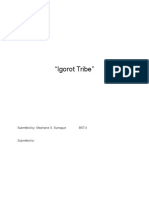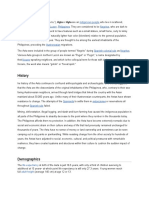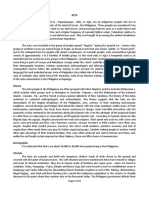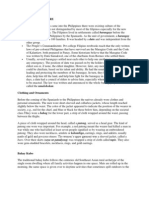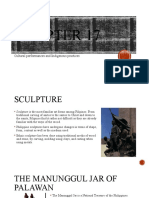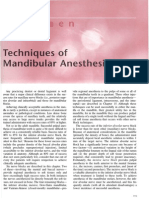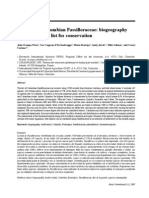Lallo
Lallo
Uploaded by
LadyShane TuppalCopyright:
Available Formats
Lallo
Lallo
Uploaded by
LadyShane TuppalOriginal Description:
Original Title
Copyright
Available Formats
Share this document
Did you find this document useful?
Is this content inappropriate?
Copyright:
Available Formats
Lallo
Lallo
Uploaded by
LadyShane TuppalCopyright:
Available Formats
Lallo Lallo has a rich historical background.
During the early part of the 16th century, Lallo was the hub of religious, trade and commercial activities in Northern Cagayan. One of the first four cities in the Philippines Lalloc, old name for Lallo, benefited and enjoyed the gifts from the Papal Throne. In those years, Lallo had three parishes. The parish of the Cathedral was served by the Seculars up to 1786. This was located in the "Centro" where the present Santo Domingo church now stands. The parish of Bagumbayan was entrusted to the Dominicans by Bishop Diego de Soria in 1613. The third, the parish of Tucalana, also under the Dominicans, was located in the present site of the "Compania Tabacalera," the ruins of which were used by the said company as foundations for their buildings and warehouses. During the last World War, Lallo was made the central office of the "Gunmai" (Naric) which was controlled by the Imperial Army of Japan Pictures/video Picture of an Aeta Narration Sound fxs Aeta or Agta, are an Instrumental music (Kulintang indigenous people who live in and Gong) scattered, isolated mountainous parts of Luzon, Philippines. They are considered to be Negritos, who are dark to very dark brown-skinned and tend to have features such as a small stature, small frame, curly to kinky afro-like textured hair with a higher frequency of naturally lighter hair color (blondism) relative to the general population, small nose, and dark brown eyes. They are thought to be among the earliest inhabitants of the Philippines The Aeta were included in the group of people termed "Negrito" during Spanish colonial rule as Negritos. Various Aeta groups in northern Luzon are known as "Pugut" or "Pugot," a name designated by their Ilocanospeaking neighbors, and which is the colloquial term for those with darker complexions.
Picture of aeta with leaves on hair
Pictures of aeta children
Pictures of Aeta family
All Aeta communities have adopted the language of their Austronesian Filipino neighbors, which have sometimes diverged over time to become different languages.[7] These include, in order of number of speakers, Mag-indi, Magantsi, Abellen, Ambala, and Mariveleo. There are different views on the dominant character of the Aeta religion. Those who believe they are monotheistic argue that various Aeta tribes believe in a supreme being who rules over lesser spirits or deities, with the Aeta of Mt. Pinatubo worshipping "Apo Na". The Aetas are also animists. For example, the Pinatubo Aeta believe in environmental spirits such as anito and kamana. They believe that good and evil spirits inhabit the environment, such as the spirits of the river, sea, sky, mountain, hill, valley and other places. No special occasion is needed for the Aeta to pray, although there is a clear link between prayer and economic activities. The Aeta dance before and after a pig hunt. The night before Aeta women gather shellfish, they perform a dance which is partly an apology to the fish and partly a charm to ensure the catch. Similarly, the men hold a bee dance before and after the expeditions for honey.
Pictures of Aeta with their traditional clothing.
Pictures of Aeta with their skillsand practices.
Traditional medicines
With their arts
Their traditional clothing is very plain. The young women wear wrap around skirts. Elder women wear bark cloth, while elder men wear loin cloths. The old women of the Agta wear a bark cloth strip which passes between the legs, and is attached to a string around the waist. Today most Aeta who have been in contact with lowlanders have adopted the T-shirts, pants and rubber sandals commonly used by the latter. The Aetas are skillful in weaving and plaiting. Women exclusively weave winnows and mats. Only men make armlets. They also produce raincoats made of palm leaves whose bases surround the neck of the wearer, and whose topmost part spreads like a fan all around the body. Aeta women are known around the country as experts of the herbal medicines A traditional form of visual art is body scarification. The Aetas intentionally wound the skin on their back, arms, breast, legs, hands, calves and abdomen, and then they irritate the wounds with fire, lime and other means to form scars.
Their Music
Pictures on Aetas
Video on their traditional way of producing fire.
Video of aetas on their way of living.
The Aeta have a musical heritage consisting of various types of agung ensembles ensembles composed of large hanging, suspended or held, bossed/knobbed gongs which act as drone without any accompanying melodic instrument. The Municipality of Lal-lo is one of the first four cities in the Philippines. Lal-lo (formerly named Nueva Segovia) for a time enjoyed the lavish gifts of the Papal Throne. It was named Nueva Segovia by Juan Pablo Carreon in 1581. It was visited by Juan Salcedo in 1572 and Luis Perez Dasmarias in 1592. Because of its navigable river, it was chosen the capital of Cagayan Valley. Lal-lo has a total land area of 70,280 hectares or 702.80 square kilometers representing 7.08 % of the total 9,002 square kilometers land area of the province of Cagayan and has at present thirty five (35) component barangays. The town belongs to 1st class municipality. The aetas usually produce fire out of bamboo by rubbing or scouring two pieces of bamboo to produce fiction and heat. They used wooden mortal and pestle to grind and its traditional way of milling of rice.
Video of aetas in school
Nowadays, young generation goes to school. These children walks more than kilometers just to be in school. They mingle with their group.
You might also like
- Culture AdelDocument8 pagesCulture AdelJorenal BenzonNo ratings yet
- Arawak SDocument6 pagesArawak SOnica Doyle100% (1)
- Contemporary Arts From CAR (Cordillera Administrative Region)Document40 pagesContemporary Arts From CAR (Cordillera Administrative Region)Jan Maverick Agbunag92% (26)
- History of The Sakuting Philippine Folk DanceDocument2 pagesHistory of The Sakuting Philippine Folk DanceMargie Ballesteros Manzano17% (6)
- Igorot TribeDocument8 pagesIgorot TribeStephanie SumagueNo ratings yet
- LAN Model Paper SchemeDocument9 pagesLAN Model Paper SchemeSudhan SudhanNo ratings yet
- The Aeta Narrative EssayDocument5 pagesThe Aeta Narrative EssayBhelenda BobilesNo ratings yet
- History: Indigenous People Luzon Philippines NegritosDocument7 pagesHistory: Indigenous People Luzon Philippines NegritosKaren Mae AlcantaraNo ratings yet
- The Aeta People: Ma. Ellisah Guino Humss 1B Zharmayne Geslie Garcia Virlee Ann Orlino Renalyn Panaligan Dianna CunananDocument7 pagesThe Aeta People: Ma. Ellisah Guino Humss 1B Zharmayne Geslie Garcia Virlee Ann Orlino Renalyn Panaligan Dianna Cunananpreciousaragon042gmailcomNo ratings yet
- AetaDocument3 pagesAetaFranc Lawrence Garcia GlarceNo ratings yet
- The AetaDocument10 pagesThe AetaDaren DazNo ratings yet
- Narrative 6 PagesDocument6 pagesNarrative 6 PagesmjagaborNo ratings yet
- The Aeta (AytaDocument4 pagesThe Aeta (AytaKibz BarrieNo ratings yet
- Hard Bound ReportDocument6 pagesHard Bound Reportchristian ifurungNo ratings yet
- Philippine History (With Gender Issues) Chapter 6Document8 pagesPhilippine History (With Gender Issues) Chapter 6Genemar Tan MarteNo ratings yet
- Cordillera Spanish DanceDocument9 pagesCordillera Spanish DanceAlrence HilarioNo ratings yet
- Presentation 4Document16 pagesPresentation 4raymartdelrosario322No ratings yet
- Aeta PeoplesDocument8 pagesAeta PeoplesDom AgawaNo ratings yet
- Ethnic Groups in The Philippines - 20231004 - 152917 - 0000Document97 pagesEthnic Groups in The Philippines - 20231004 - 152917 - 0000Mampusti MarlojaykeNo ratings yet
- Jelly AnnDocument12 pagesJelly Annjelly ann berdijoNo ratings yet
- GROUP 4 Indigenous People of Luzon. PresentationDocument77 pagesGROUP 4 Indigenous People of Luzon. PresentationAl-yaser IllangNo ratings yet
- STS Week 5 6Document48 pagesSTS Week 5 6Richard JuridicoNo ratings yet
- SAKUTING-History of The Sakuting Philippine Folk DanceDocument6 pagesSAKUTING-History of The Sakuting Philippine Folk DancePao LeenaNo ratings yet
- Dance Origin in The PhilippinesDocument5 pagesDance Origin in The PhilippinesJeffrey PeñanoNo ratings yet
- Region 8Document18 pagesRegion 8Carmela LucilleNo ratings yet
- Conarts 2Document4 pagesConarts 2Danielle MerlinNo ratings yet
- Aeta ReportDocument30 pagesAeta ReportSheen Shane Xaii100% (2)
- Lesson 3 Dance Education ProgramDocument16 pagesLesson 3 Dance Education Programtherenz gerald olazoNo ratings yet
- Tinikling ReviewDocument12 pagesTinikling ReviewApril RoscoNo ratings yet
- GAMABADocument9 pagesGAMABAJerome PaulinoNo ratings yet
- CultureDocument5 pagesCultureKathleen MoralesNo ratings yet
- Folk DanceDocument9 pagesFolk DanceSherren Marie NalaNo ratings yet
- TiniklingDocument7 pagesTiniklingLeila NuñezNo ratings yet
- Aeta GroupDocument4 pagesAeta GroupHarlyn May GerianeNo ratings yet
- Ilocano People - WikipediaDocument36 pagesIlocano People - WikipediaChris PittsNo ratings yet
- CarDocument35 pagesCarIvan Kaine BulaunNo ratings yet
- Ilocano Cultures and TraditionsDocument3 pagesIlocano Cultures and TraditionsEunice Pineza ManlunasNo ratings yet
- 2overview of Philippine ArtsDocument45 pages2overview of Philippine ArtsAngel WhuyoNo ratings yet
- Dances in The PhilippinesDocument29 pagesDances in The PhilippinesCrisandro VillarbaNo ratings yet
- The Aeta People of The PhilippinesDocument78 pagesThe Aeta People of The PhilippinesMiles JeromeNo ratings yet
- Week 3 Aand 4 ContemporaryDocument15 pagesWeek 3 Aand 4 ContemporaryJonathan FernandezNo ratings yet
- Folk Dance ReadingsDocument6 pagesFolk Dance ReadingsGlorielle SorreraNo ratings yet
- FOLK DANCE ReadingsDocument6 pagesFOLK DANCE ReadingsGlorielle SorreraNo ratings yet
- RPH Che1 2Document239 pagesRPH Che1 2Clara GageloniaNo ratings yet
- Canlas, Katrina Dela Cruz, Akiko Delos Reyes, Jose Junio, Demi Penilla, Rosmir Samonte, PatriciaDocument36 pagesCanlas, Katrina Dela Cruz, Akiko Delos Reyes, Jose Junio, Demi Penilla, Rosmir Samonte, PatriciapatriciaNo ratings yet
- History of DanceDocument40 pagesHistory of DanceSheramae CadungogNo ratings yet
- CAR SoftDocument12 pagesCAR SoftJamaica Roman SacdalanNo ratings yet
- Indigenous People in Northern LuzonDocument73 pagesIndigenous People in Northern LuzonJhanice DepalcoNo ratings yet
- Aetas 1Document12 pagesAetas 1Angeline DabuNo ratings yet
- Folk DanceDocument6 pagesFolk DancePrince KhyleNo ratings yet
- As Mapeh M4Document7 pagesAs Mapeh M4Erl CasiñoNo ratings yet
- Philippines Folk DanceDocument3 pagesPhilippines Folk DanceLiannKwon50% (2)
- Cultural Performances and Indigenous PracticesDocument14 pagesCultural Performances and Indigenous PracticesJohn Raven TobeoNo ratings yet
- Philippine History Let NotesDocument9 pagesPhilippine History Let NotesJerlyn Mae S. QuiliopeNo ratings yet
- Ati Tribe: Members: Debuque, Therese Antonette Honrales, Satcha Sta. Maria, Skylette Palma, PaoloDocument4 pagesAti Tribe: Members: Debuque, Therese Antonette Honrales, Satcha Sta. Maria, Skylette Palma, PaoloMj AlbaNo ratings yet
- Aetas HistoryDocument5 pagesAetas HistoryJennifer dela CruzNo ratings yet
- Dance Panay Island Spaniards Philippines Spanish Bolero Mexican Jarabe TapatioDocument16 pagesDance Panay Island Spaniards Philippines Spanish Bolero Mexican Jarabe TapatioWilson Morano0% (1)
- FolkdanceDocument5 pagesFolkdanceDonita Sotolombo100% (1)
- SAKUTINGDocument4 pagesSAKUTINGAnonymous jth1gcGBCNo ratings yet
- The Tinguian: Social, Religious, and Economic Life of a Philippine TribeFrom EverandThe Tinguian: Social, Religious, and Economic Life of a Philippine TribeNo ratings yet
- 4744-Article Text-49948-1-10-20211204Document8 pages4744-Article Text-49948-1-10-20211204LadyShane TuppalNo ratings yet
- Ipcr Sample RkoDocument18 pagesIpcr Sample RkoLadyShane TuppalNo ratings yet
- Cordova National High Schoo1Document3 pagesCordova National High Schoo1LadyShane TuppalNo ratings yet
- Episode 6Document4 pagesEpisode 6LadyShane TuppalNo ratings yet
- FullerenesDocument411 pagesFullereneslsueyinNo ratings yet
- dcp2000 Mib Description 000494 v1 0Document9 pagesdcp2000 Mib Description 000494 v1 0Ivan DenisovNo ratings yet
- Section 3 Power Train System: Group 1 Structure and OperationDocument18 pagesSection 3 Power Train System: Group 1 Structure and OperationAndré TarginoNo ratings yet
- TM 170 Balancing Apparatus Gunt 1378 PDF 1 en GBDocument3 pagesTM 170 Balancing Apparatus Gunt 1378 PDF 1 en GBlegasuNo ratings yet
- 5e Houserule Psionic ClassesDocument3 pages5e Houserule Psionic ClassesTanner YeaNo ratings yet
- Lifting Lug Design - USA Air Force MethodDocument15 pagesLifting Lug Design - USA Air Force MethodOSCARDELTANo ratings yet
- Choledochal CystDocument3 pagesCholedochal CystIqra FatemahNo ratings yet
- 14 Techniques of Mandibular AnesthesiaDocument27 pages14 Techniques of Mandibular Anesthesiaapi-3711066100% (7)
- Standard Notes To Tenderers For GCC ContractsDocument79 pagesStandard Notes To Tenderers For GCC ContractsZoe TNo ratings yet
- WOR KIN PRO Gres S: Rules & QuestsDocument37 pagesWOR KIN PRO Gres S: Rules & QuestsMichael Johnson100% (1)
- Silo - Tips - Metals Magazine Efficient ProfessionalDocument76 pagesSilo - Tips - Metals Magazine Efficient Professionalirina.ruturNo ratings yet
- Sungrow SG50KTL-M-20 - Auszug Aus Dem Prüfbericht Zum Einheiten - Zertifikat - DEDocument176 pagesSungrow SG50KTL-M-20 - Auszug Aus Dem Prüfbericht Zum Einheiten - Zertifikat - DERodrigo MussattoNo ratings yet
- Classroom Exercise ProblemsDocument4 pagesClassroom Exercise Problemssarahvamp14No ratings yet
- Passiflora and BiogeogrfiaDocument45 pagesPassiflora and BiogeogrfiaJuan TiradoNo ratings yet
- A Study of Materials For Solar PV Technology and Challenges: March 2017Document14 pagesA Study of Materials For Solar PV Technology and Challenges: March 2017Tanmay HazraNo ratings yet
- Rain Water HarvestingDocument21 pagesRain Water HarvestingVinayPawarNo ratings yet
- Endless Shadow - John BrunnerDocument82 pagesEndless Shadow - John Brunnershockwaverider3000No ratings yet
- Problem 2:: CEET 521 PrelimDocument2 pagesProblem 2:: CEET 521 PrelimTracy Anne VillamorNo ratings yet
- Edited Cow ShedDocument4 pagesEdited Cow ShedRam pakhrin100% (1)
- Funny People Final Script PDFDocument153 pagesFunny People Final Script PDFHafsa BoudguigNo ratings yet
- q3 Tle7Document14 pagesq3 Tle7Princess VillanuevaNo ratings yet
- Mba Project Report On HRDocument65 pagesMba Project Report On HRSwati MishraNo ratings yet
- Expirement No 1Document4 pagesExpirement No 1Rajiv KharbandaNo ratings yet
- Ashrae D 90455Document450 pagesAshrae D 90455Alejandro Darlington MirandaNo ratings yet
- CAOLBOY Module 14 Activity Worksheets 1 1Document7 pagesCAOLBOY Module 14 Activity Worksheets 1 1Anton LeoncitoNo ratings yet
- SBAS350520059ENR0Document41 pagesSBAS350520059ENR0Douglas LopesNo ratings yet
- Phy - 101 Mid Term by Vu Topper RMDocument16 pagesPhy - 101 Mid Term by Vu Topper RMhira anwar100% (1)
- Catalogo FAVETON Eng12p PDFDocument24 pagesCatalogo FAVETON Eng12p PDFAndressaMTNo ratings yet
- ADA Viva Questions Unit 1 and 2Document5 pagesADA Viva Questions Unit 1 and 2Yash PatelNo ratings yet




